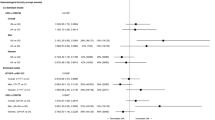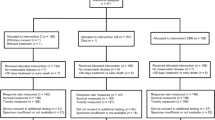Abstract
This study was designed to analyze the gender-related association between SCN1A polymorphisms (voltage-gated sodium channels; α-subunit) and time-to-recurrence (TTR) in patients with colorectal cancer (CRC) treated with 5-fluoruracil (5-FU)-based adjuvant chemotherapy. We enrolled from a prospective database patients with stage II and III CRC treated with adjuvant 5-FU-based chemotherapy. Genotypes for SCN1A rs3812718 and rs229877 were determined by direct DNA sequencing. One hundred twenty-seven males and 107 females were included in the study. In the univariate and multivariate analysis, the shortest TTR was associated with female patients carrying the rs3812718-TT genotype (hazard ratio (HR): 2.26 (95% confidence interval (CI): 0.89, 5.70), P=0.039) but with male patients carrying the rs3812718-CC genotype (HR: 0.49 (95% CI: 0.18, 1.38), P=0.048). For rs229877 the CT genotype was associated with a trend for shorter TTR in both gender populations. The study validated gender-dependent association between genomic SCN1A rs3812718 polymorphism and TTR in CRC patients treated with adjuvant 5-FU-based chemotherapy. This study confirms that voltage-gated Na+ channels may be a potential therapeutic target and a useful predictive biomarker before 5-FU infusion.
This is a preview of subscription content, access via your institution
Access options
Subscribe to this journal
Receive 6 print issues and online access
$259.00 per year
only $43.17 per issue
Buy this article
- Purchase on Springer Link
- Instant access to full article PDF
Prices may be subject to local taxes which are calculated during checkout






Similar content being viewed by others
References
Siegel R, Naishadham D, Jemal A . CA cancer statistics, 2013. Cancer J Clin 2013; 63: 11–30.
Gill S, Loprinzi CL, Sargent DJ, Thomé SD, Alberts SR, Haller DG et al. Pooled analysis of fluorouracil-based adjuvant therapy for stage II and III colon cancer: who benefits and by how much? J Clin Oncol 2004; 22: 1797.
André T, Boni C, Navarro M, Tabernero J, Hickish T, Topham C et al. Improved overall survival with oxaliplatin, fluorouracil, and leucovorin as adjuvant treatment in stage II or III colon cancer in the MOSAIC trial. J Clin Oncol 2009; 27: 3109.
Quah HM, Chou JF, Gonen M, Shia J, Schrag D, Landmann RG et al. Identification of patients with high-risk stage II colon cancer for adjuvant therapy. Dis Colon Rectum 2008; 51: 503–507.
Lièvre A, Bachet JB, Boige V, Cayre A, Le Corre D, Buc E et al. KRAS mutations as an independent prognostic factor in patients with advanced colorectal cancer treated with cetuximab. J Clin Oncol 2008; 26: 374–379.
De Roock W, Claes B, Bernasconi D, De Schutter J, Biesmans B, Fountzilas G et al. Effects of KRAS, BRAF, NRAS, and PIK3CA mutations on the efficacy of cetuximab plus chemotherapy in chemotherapy-refractory metastatic colorectal cancer: a retrospective consortium analysis. Lancet Oncol 2010; 11: 753–762.
Laurent-Puig P, Cayre A, Manceau G, Buc E, Bachet JB, Lecomte T et al. Analysis of PTEN, BRAF, and EGFR status in determining benefit from cetuximab therapy in wild-type KRAS metastatic colon cancer. J Clin Oncol 2009; 27: 5924–5930.
Lanza G, Gafà R, Santini A, Maestri I, Guerzoni L, Cavazzini L . Immunohistochemical test for MLH1 and MSH2 expression predicts clinical outcome in stage II and III colorectal cancer patients. J Clin Oncol 2006; 24: 2359–2367.
Benhaim L, Labonte MJ, Lenz HJ . Pharmacogenomics and metastatic colorectal cancer: current knowledge and perspectives. Scand J Gastroenterol 2012; 47: 325–339.
Ekberg J, Adams DJ . Neuronal voltage-gated sodium channel subtypes: key roles in inflammatory and neuropathic pain. Int J Biochem Cell Biol 2006; 38: 2005–2010.
Camerino DC, Desaphy JF, Tricarico D, Pierno S, Liantonio A . Therapeutic approaches to ion channel diseases. Adv Genet 2008; 64: 81–145.
Hernandez-Plata E, Ortiz CS, Marquina-Castillo B, Medina-Martinez I, Alfaro A, Berumen J et al. Overexpression of NaV 1.6 channels is associated with the invasion capacity of human cervical cancer. Int J Cancer 2012; 130: 2013–2023.
Diss JK, Stewart D, Pani F, Foster CS, Walker MM, Patel A et al. A potential novel marker for human prostate cancer: voltage-gated sodium channel expression in vivo. Prostate Cancer Prostatic Dis 2005; 8: 266–273.
Fraser SP, Diss JK, Chioni AM, Mycielska ME, Pan H, Yamaci RF et al. Voltage-gated sodium channel expression and potentiation of human breast cancer metastasis. Clin Cancer Res 2005; 11: 5381–5389.
Gao R, Shen Y, Cai J, Lei M, Wang Z . Expression of voltage-gated sodium channel alpha subunit in human ovarian cancer. Oncol Rep 2010; 23: 1293–1299.
House CD, Vaske CJ, Schwartz AM, Obias V, Frank B, Luu T et al. Voltage-gated Na+ channel SCN5A is a key regulator of a gene transcriptional network that controls colon cancer invasion. Cancer Res 2010; 70: 6957–6967.
Diaz D, Delgadillo DM, Hernández-Gallegos E, Ramírez-Domínguez ME, Hinojosa LM, Ortiz CS et al. Functional expression of voltage-gated sodium channels in primary cultures of human cervical cancer. J Cell Physiol 2007; 210: 469–478.
Roger S, Rollin J, Barascu A, Besson P, Raynal PI, Iochmann S et al. Voltage-gated sodium channels potentiate the invasive capacities of human non-small-cell lung cancer cell lines. Int J Biochem Cell Biol 2007; 39: 774–786.
Sjöblom T, Jones S, Wood LD, Parsons DW, Lin J, Barber TD et al. The consensus coding sequences of human breast and colorectal cancers. Science 2006; 314: 268–274.
Can G, Akpinar B, Baran Y, Zhivotovsky B, Olsson M . 5-fluorouracil signaling through a calcium-calmodulin-dependent pathway is required for p53 activation and apoptosis in colon carcinoma cells. Oncogene, advance online publication, 29 October 2012 (e-pub ahead of print).
Thompson CH, Kahlig KM, George AL Jr. . SCN1A splice variants exhibit divergent sensitivity to commonly used antiepileptic drugs. Epilepsia 2011; 52: 1000–1009.
Le Gal F, Salzmann A, Crespel A, Malafosse A . Replication of association between a SCN1A splice variant and febrile seizures. Epilepsia 2011; 52: e135–e138.
Schlachter K, Gruber-Sedlmayr U, Stogmann E, Lausecker M, Hotzy C, Balzar J et al. A splice site variant in the sodium channel gene SCN1A confers risk of febrile seizures. Neurology 2009; 72: 974–978.
Lakhan R, Kumari R, Misra UK, Kalita J, Pradhan S, Mittal B . Differential role of sodium channels SCN1A and SCN2A gene polymorphisms with epilepsy and multiple drug resistance in the north Indian population. Br J Clin Pharmacol 2009; 68: 214–220.
Nagashima F, Zhang W, Yang D, Gordon M, Schultheis A, Fazzone W et al. Polymorphism in sodium-channel alpha 1-subunit (SCNIA) predicts response, TTP, survival, and toxicity in patients with metastatic colorectal cancer treated with 5-FU/oxaliplatin. J Clin Oncol, (Meeting Abstracts) 2006; 24 (18 Suppl): 3533.
Gordon MA, Zhang W, Yang D, Iqbal S, El-Khouiery A, Nagashima F et al. Gender-specific genomic profiling in metastatic colorectal cancer patients treated with 5-fluorouracil and oxaliplatin. Pharmacogenomics 2011; 12: 27–39.
Brackenbury WJ . Voltage-gated sodium channels and metastatic disease. Channels (Austin) 2012; 6: 352–361.
Ferlitsch M, Reinhart K, Pramhas S, Wiener C, Gal O, Bannert C et al. Sex-specific prevalence of adenomas, advanced adenomas, and colorectal cancer in individuals undergoing screening colonoscopy. JAMA 2011; 306: 1352–1358.
Nguyen SP, Bent S, Chen YH, Terdiman JP . Gender as a risk factor for advanced neoplasia and colorectal cancer: a systematic review and meta-analysis. Clin Gastroenterol Hepatol 2009; 7: 676–681, e1-3.
Hendifar A, Yang D, Lenz F, Lurje G, Pohl A, Lenz C et al. Gender disparities in metastatic colorectal cancer survival. Clin Cancer Res 2009; 15: 6391–6397.
Koo JH, Jalaludin B, Wong SK, Kneebone A, Connor SJ, Leong RW . Improved survival in young women with colorectal cancer. Am J Gastroenterol 2008; 103: 1488–1495.
Rossouw JE, Anderson GL, Prentice RL, LaCroix AZ, Kooperberg C, Stefanick ML et al. Risks and benefits of estrogen plus progestin in healthy postmenopausal women: principal results from the Women’s Health Initiative randomized controlled trial. JAMA 2002; 288: 321–333.
Cho YK, Kim HC, Kim SH, Park JH, Yun HR, Cho YB et al. Location-related differences in sporadic microsatellite unstable colorectal cancer. Dig Liver Dis 2010; 42: 611–615.
Kim YH, Min BH, Kim SJ, Choi HK, Kim KM, Chun HK et al. Difference between proximal and distal microsatellite-unstable sporadic colorectal cancers: analysis of clinicopathological and molecular features and prognoses. Ann Surg Oncol 2010; 17: 1435–1441.
Fernández-Contreras ME, Sánchez-Hernández JJ, Guijarro M, Gisbert JP, Rivas N, García de Paredes ML et al. Influence of thymidylate synthase DNA polymorphisms and gender on the clinical evolution of patients with advanced colorectal cancer. Oncol Rep 2010; 23: 1393–1400.
Pellegrini P, Contasta I, Del Beato T, Ciccone F, Berghella AM . Gender-specific cytokine pathways, targets, and biomarkers for the switch from health to adenoma and colorectal cancer. Clin Dev Immunol 2011; 2011: 819724.
Mariani M, Zannoni GF, Sioletic S, Sieber S, Martino C, Martinelli E et al. Gender influences the class III and V β-tubulin ability to predict poor outcome in colorectal cancer. Clin Cancer Res 2012; 18: 2964–2975.
Tadić A, Baskaya O, Victor A, Lieb K, Höppner W, Dahmen N . Association analysis of SCN9A gene variants with borderline personality disorder. J Psychiatr Res 2008; 43: 155–163.
Blechschmidt S, Haufe V, Benndorf K, Zimmer T . Voltage-gated Na+ channel transcript patterns in the mammalian heart are species-dependent. Prog Biophys Mol Biol 2008; 98: 309–318.
Lowe JS, Stroud DM, Yang T, Hall L, Atack TC, Roden DM . Increased late sodium current contributes to long QT-related arrhythmia susceptibility in female mice. Cardiovasc Res 2012; 95: 300–307.
Fraser SP, Ozerlat-Gunduz I, Onkal R, Diss JK, Latchman DS, Djamgoz MB . Estrogen and non-genomic upregulation of voltage-gated Na(+) channel activity in MDA-MB-231 human breast cancer cells: role in adhesion. J Cell Physiol 2010; 224: 527–539.
Chen SZ, Jiang M, Zhen YS . HERG K+ channel expression-related chemosensitivity in cancer cells and its modulation by erythromycin. Cancer Chemother Pharmacol 2005; 56: 212–220.
Andrikopoulos P, Fraser SP, Patterson L, Ahmad Z, Burcu H, Ottaviani D et al. Angiogenic functions of voltage-gated Na+ channels in human endothelial cells: modulation of vascular endothelial growth factor (VEGF) signaling. J Biol Chem 2011; 286: 16846–16860.
Uysal-Onganer P, Djamgoz MB . Epidermal growth factor potentiates in vitro metastatic behaviour of human prostate cancer PC-3 M cells: involvement of voltage-gated sodium channel. Mol Cancer 2007; 6: 76.
Author information
Authors and Affiliations
Corresponding author
Ethics declarations
Competing interests
The authors declare no conflict of interest.
Rights and permissions
About this article
Cite this article
Benhaim, L., Gerger, A., Bohanes, P. et al. Gender-specific profiling in SCN1A polymorphisms and time-to-recurrence in patients with stage II/III colorectal cancer treated with adjuvant 5-fluoruracil chemotherapy. Pharmacogenomics J 14, 135–141 (2014). https://doi.org/10.1038/tpj.2013.21
Received:
Revised:
Accepted:
Published:
Issue Date:
DOI: https://doi.org/10.1038/tpj.2013.21



